JavaScript continues to be the lifeblood of web development in 2025, shaping the way we build websites, applications, and even server-side solutions. According to the Stack Overflow Developer Survey 2024, JavaScript is the for the twelfth consecutive year, with a usage rate exceeding 65% among professional developers. This statistic underscores its ubiquity across industries and platforms.
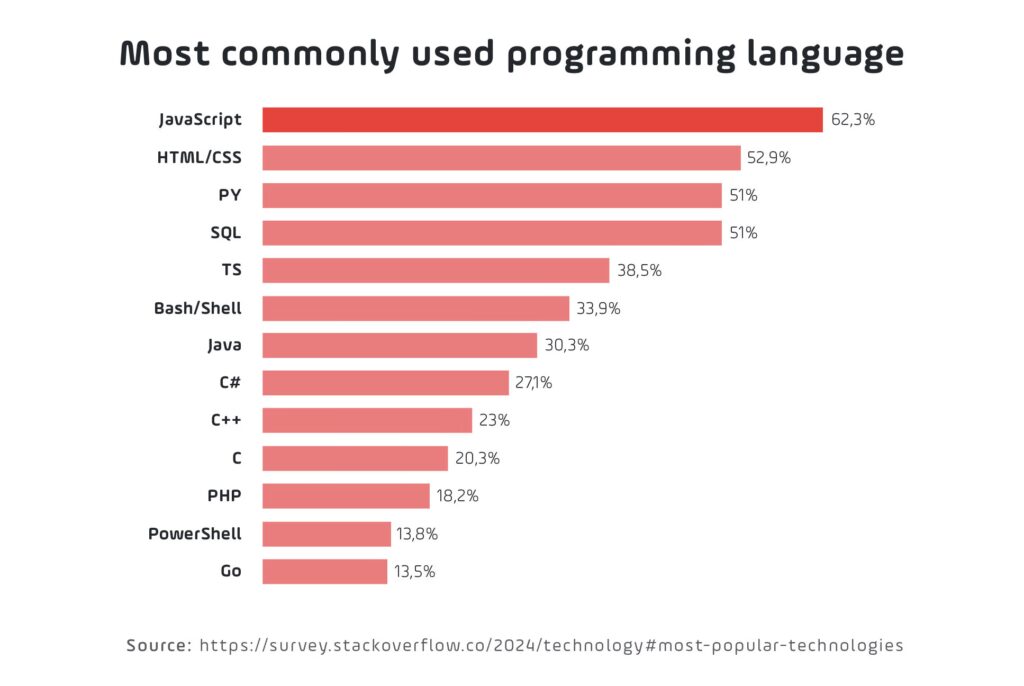
The language’s adaptability plays a pivotal role in its enduring success. From traditional front-end frameworks like React and Angular to modern server-side solutions powered by Node.js, JavaScript remains at the forefront of innovation. Tools such as GraphQL, TypeScript, and WebAssembly are expanding JavaScript’s potential, making it a language capable of handling diverse and complex requirements.
But staying relevant in such a dynamic ecosystem requires more than familiarity with the basics. Developers must embrace cutting-edge tools, adopt modern features, and understand emerging trends to deliver scalable, maintainable, and performant applications. Insights from the State of JavaScript 2024 survey reveal that many professionals are already adopting advanced tools like Vite for faster development workflows, TypeScript for static typing, and ECMAScript’s latest features for concise and efficient code.
This blog post delves into ten critical features and tools every JavaScript developer should master in 2025. Whether you’re optimizing APIs with GraphQL, leveraging the power of Node.js on the server, or integrating high-performance WebAssembly modules, this guide will help you stay ahead in the rapidly evolving world of JavaScript.
1. Pattern Matching in JavaScript
Pattern matching is poised to be a revolutionary addition to JavaScript, inspired by functional programming languages like Scala and Haskell. While still in the proposal stage, its potential to simplify complex branching logic makes it one of the most anticipated ECMAScript features.
What is Pattern Matching?
Pattern matching allows developers to compare a value against multiple patterns and execute logic based on the first match. It’s an alternative to traditional if-else or switch statements, enabling concise and readable branching logic.
How Pattern Matching Works
At its core, pattern matching evaluates the structure and content of a value to determine its behavior. Here’s an example of how it might look:

In this example:
- when { type: ‘admin’, active: true } checks if the object matches a specific structure and values.
- else acts as a fallback case, ensuring all scenarios are accounted for.
Benefits of Pattern Matching
- Cleaner Code: Simplifies complex conditional logic.
- Exhaustive Matching: Forces developers to handle all possible cases, reducing bugs.
- Declarative Syntax: Encourages a focus on what the code does, not how it does it.
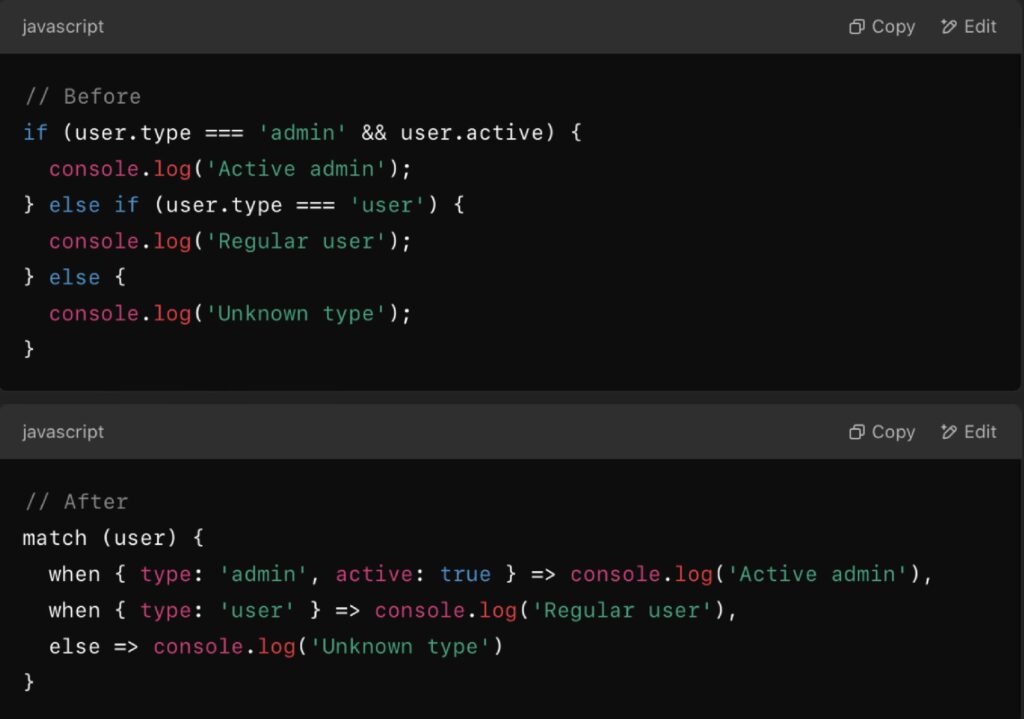
Trend in 2025
According to the State of JavaScript 2024 survey, developers are eager for features that reduce verbosity and improve maintainability. Although not yet native to JavaScript, tools like ts-pattern allow developers to leverage similar functionality today.
Example: Using ts-pattern
With libraries like ts-pattern, you can experiment with pattern matching right now:
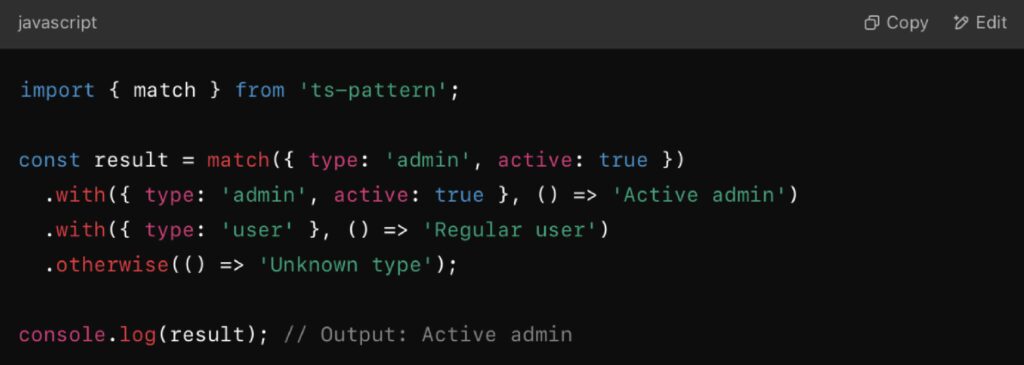
Use Cases
- Complex State Management: Simplify logic in React reducers or Vuex stores.

- API Response Handling: Dynamically handles different response formats from APIs.
javascript

- Error Handling: Streamline exception management in applications.
Challenges and Adoption
- Current Limitations: Pattern matching is still a proposal and not natively supported in JavaScript. Developers must rely on external libraries like ts-pattern to use this feature today.
- Learning Curve: Developers unfamiliar with functional programming paradigms may need time to adjust.
Getting Ready for Pattern Matching
To prepare for the adoption of pattern matching in JavaScript:
- Explore functional programming concepts to understand its origins.
- Experiment with libraries like ts-pattern to get comfortable with the syntax.
- Stay updated on the progress of the ECMAScript proposal.
2. Server-Side Development with Node.js
Node.js revolutionized server-side JavaScript development by enabling developers to build scalable, high-performance backends using the same language as the front end. Today, Node.js powers some of the world’s largest platforms, such as Netflix, LinkedIn, and PayPal, showcasing its ability to handle enterprise-scale applications.
Why Node.js is Indispensable
- Event-Driven Architecture: Node.js processes multiple requests simultaneously without blocking the main thread. This non-blocking I/O model is ideal for real-time applications like chat servers and online gaming.
- Rich Ecosystem: With over 1.5 million packages in the npm registry, developers can find libraries and tools for almost any requirement, from authentication to caching.
- Cross-Platform Compatibility: Node.js applications can run on various operating systems, including Linux, macOS, and Windows, making deployment seamless.
How Node.js Works
Node.js uses a single-threaded event loop model, making it highly efficient for I/O-heavy tasks. Here’s how it handles concurrent requests:
- An incoming request is received by the event loop.
- If the task is I/O-bound, Node.js delegates it to the appropriate system thread.
- Once the operation is complete, the event loop processes the callback associated with the task.
Example: Basic Node.js Server
Here’s a simple example of creating a server with Express.js:
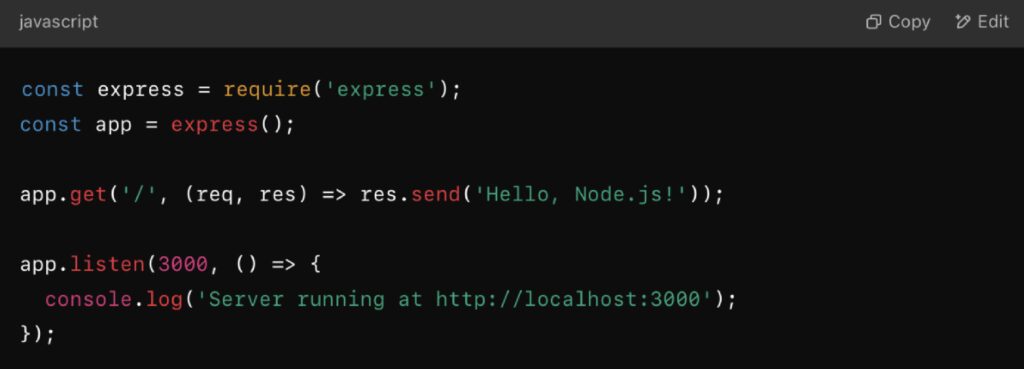
This server listens for HTTP requests on port 3000 and responds with “Hello, Node.js!” when accessed.
Key Features of Node.js
- Built-in Modules:
- fs: Handles file system operations.
- http: Creates HTTP servers and handles requests.
- path: Manages file paths across platforms.
- Example: Reading a file asynchronously with the fs module:

- Scalability: Node.js can handle thousands of simultaneous connections due to its event-driven nature.
- Real-Time Capabilities: Frameworks like Socket.IO enable real-time communication for applications like chat apps and collaborative tools.
Popular Use Cases
- Real-Time Applications: Node.js is ideal for chat servers, gaming platforms, and collaborative tools.
- API Gateways: With frameworks like Fastify, Node.js excels in creating lightweight API gateways for microservices.
- Streaming Applications: Platforms like Netflix use Node.js for its ability to handle streaming data efficiently.
- Edge Computing: Modern platforms like Vercel use Node.js to deploy edge functions, reducing latency by running code closer to users.
Trend in 2025
According to the State of JavaScript 2024 survey, Node.js remains the most widely used server-side runtime for JavaScript, but there is a noticeable shift toward integrating serverless architectures. This approach allows developers to focus on code without worrying about infrastructure management, leveraging platforms like AWS Lambda and Azure Functions.
Emerging Alternatives
While Node.js continues to dominate, alternatives like Deno are gaining traction. Created by the original Node.js developer, Deno addresses some of Node’s limitations, such as security concerns, and offers built-in TypeScript support.
Advanced Tools and Frameworks
- NestJS: A TypeScript-first framework for building scalable server-side applications.
- Koa.js: A minimalist framework for building APIs.
- PM2: A process manager for Node.js applications that supports monitoring and load balancing.
Future-Proofing Your Skills
To stay ahead in server-side JavaScript development:
- Learn serverless frameworks like Serverless Framework and integrate them with Node.js.
- Experiment with Deno to understand its features and limitations compared to Node.js.
- Practice building microservices using tools like Docker and Kubernetes.
Example Project: Real-Time Chat Application
Here’s a high-level outline for building a real-time chat app using Node.js and Socket.IO:
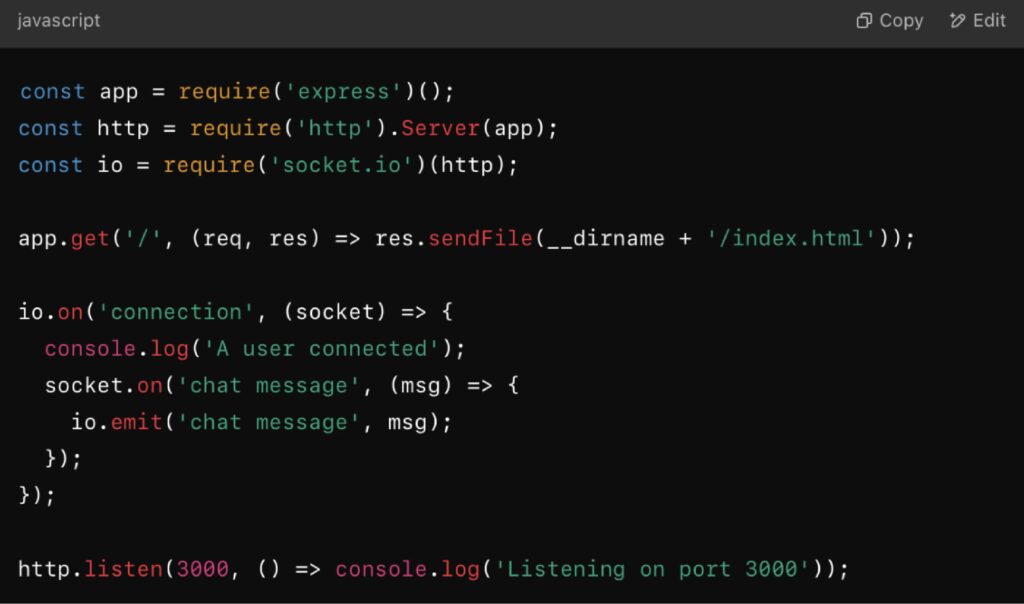
- Create a Front-End Interface: Use a simple HTML form for users to send messages.
- Set Up a Node.js Server:
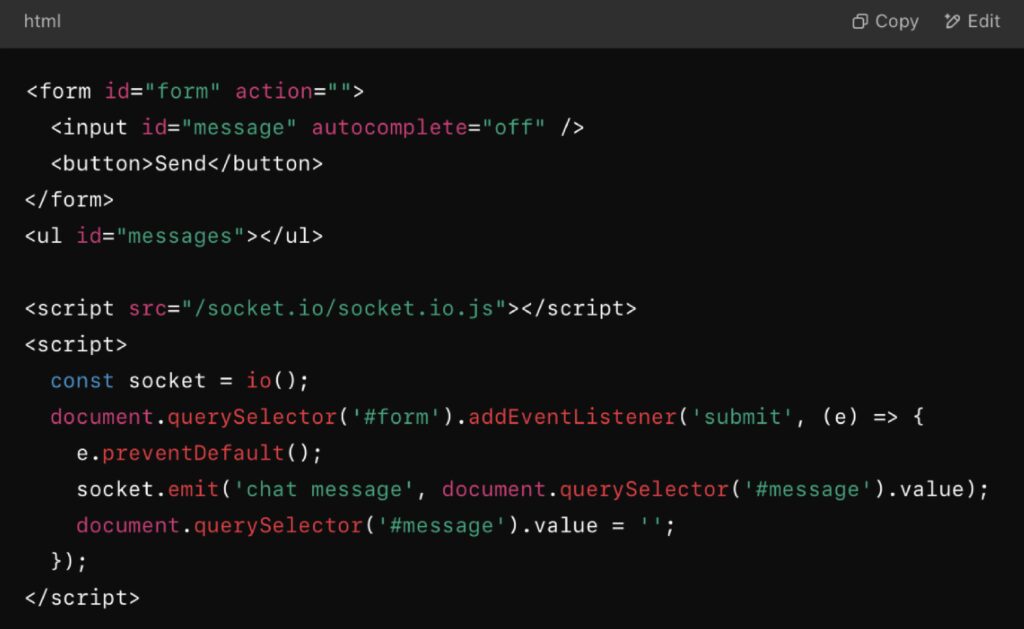
- Test the Application: Open multiple browser tabs to see the real-time communication in action.
3. Vite: The Modern Build Tool
Vite has transformed front-end development with its blazing-fast performance and developer-friendly design. Built by Evan You, the creator of Vue.js, Vite takes a modern approach to build tools, leveraging native ES Modules in development and Rollup for optimized production builds. Its simplicity and speed have made it a favorite among developers working with modern frameworks like React, Vue, and Svelte.
What is Vite?
Vite is a next-generation front-end tooling solution designed to address the performance bottlenecks of traditional bundlers like Webpack and Parcel. By serving files as native ES Modules during development, Vite eliminates the need for bundling, resulting in near-instant server starts and faster Hot Module Replacement (HMR).
Core Features
- Instant Server Start: Vite starts development servers in milliseconds by skipping the bundling process for JavaScript and CSS files.

- Hot Module Replacement (HMR): Vite’s HMR system updates only the affected modules during development, delivering near-instant feedback without refreshing the entire page.
- Optimized Production Builds: Vite uses Rollup under the hood to create efficient and tree-shaken production builds.
- Framework Support: Vite works seamlessly with React, Vue, Svelte, and even Vanilla JavaScript.
Why Developers Choose Vite
Traditional bundlers like Webpack (https://webpack.js.org/) have dominated for years, but their performance issues, particularly in large-scale applications, have led many developers to switch to Vite. By taking advantage of modern browser capabilities, Vite eliminates unnecessary overhead and speeds up development workflows.
Example Workflow with Vite
Here’s how a typical development workflow looks with Vite:
- Create a Project:

- Start the Development Server:

The server starts almost instantly, even for large projects.
- Build for Production:

This generates optimized static assets for deployment.
Trend in 2025
According to the State of JavaScript 2024 survey, Vite is rapidly becoming the tool of choice for developers due to its speed and simplicity. With its compatibility across multiple frameworks and focus on developer experience, Vite aligns with the industry trend of prioritizing faster feedback loops and optimized builds.
Use Cases for Vite
- Single-Page Applications (SPAs): Vite’s instant reloads and efficient bundling make it ideal for SPAs built with frameworks like Vue or React.
- Static Sites: Paired with modern static site generators like Astro or Eleventy, Vite ensures smooth development and deployment.
- Component Libraries: For developers building and testing reusable UI components, Vite offers a streamlined development environment.
Advanced Features
- Plugin Ecosystem: Vite has a rich plugin ecosystem for extending its functionality. For example:
- @vitejs/plugin-react: Adds React-specific optimizations.
- vite-plugin-pwa: Simplifies Progressive Web App (PWA) development.

- Custom Build Configurations: Vite’s configuration file, vite.config.js, allows for highly customizable builds. Example:

- SSR Support: Vite supports server-side rendering (SSR) out of the box, making it a great choice for applications requiring SEO optimization.
Comparison: Vite vs. Webpack
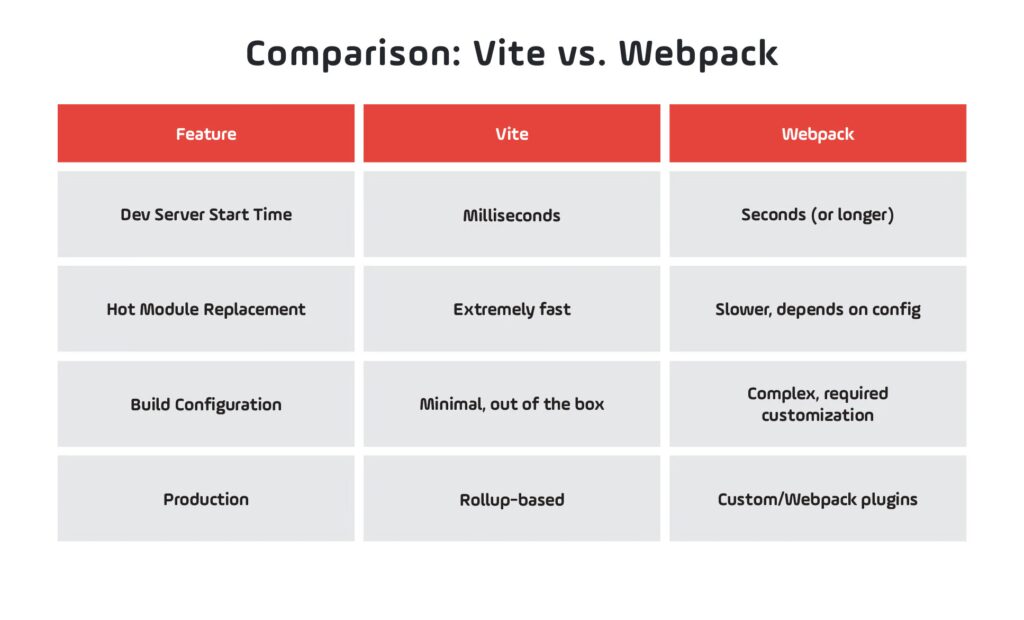
Future of Vite
In 2025, Vite is expected to continue its dominance in the front-end ecosystem as developers prioritize speed and simplicity in their workflows. Its compatibility with modern frameworks and robust plugin ecosystem ensure that it remains a critical tool for building performant applications.
4. GraphQL: A REST API Alternative
GraphQL has redefined how APIs are built and consumed, solving many of REST’s limitations by offering greater flexibility and efficiency in data retrieval. Introduced by Facebook in 2015, GraphQL empowers developers to request exactly the data they need, making it a powerful tool for modern applications.
What is GraphQL?
GraphQL is a query language and runtime for APIs. Unlike REST, where endpoints return fixed data structures, GraphQL allows clients to request only the data they need in a single query. This minimizes over-fetching and under-fetching, common pain points in REST APIs.
Core Features of GraphQL
Client-Defined Queries: With GraphQL, the client specifies the structure of the data they need, reducing unnecessary payloads.
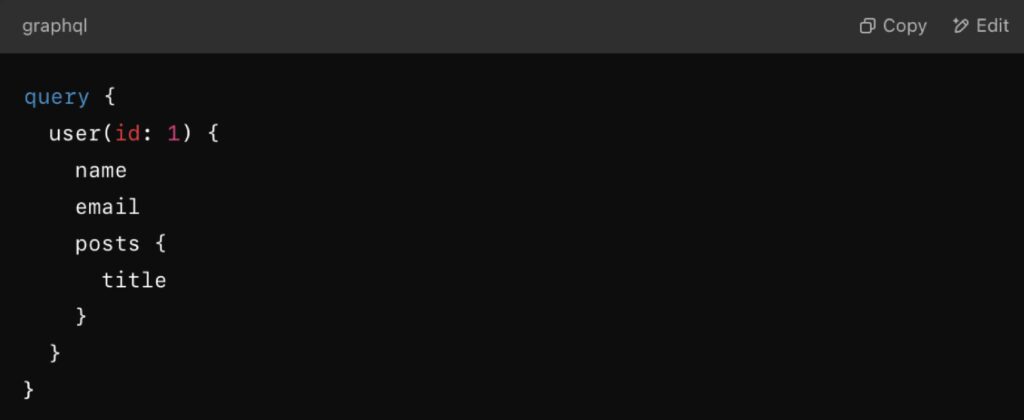
Response:
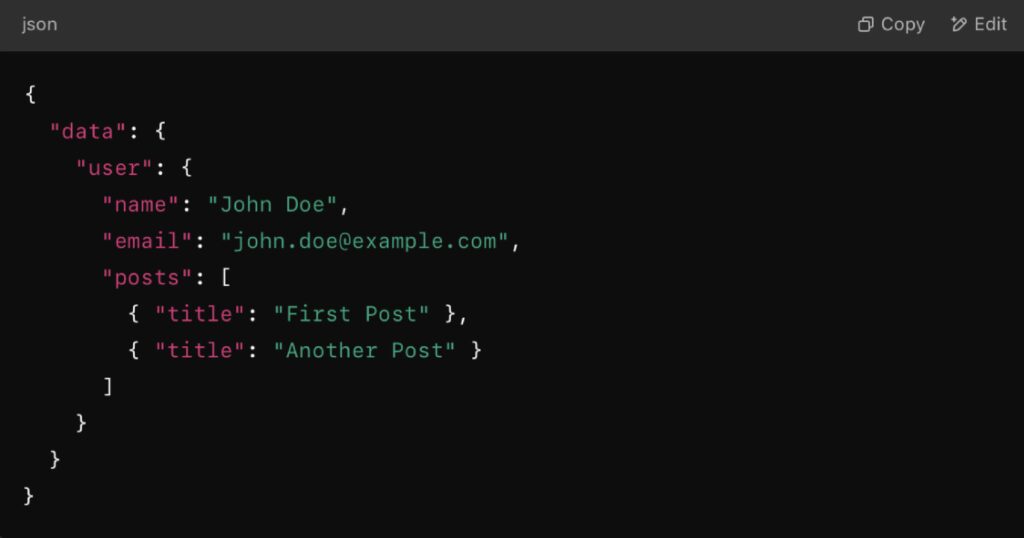
- Single Endpoint: All operations (queries, mutations, subscriptions) are handled through a single URL, simplifying API management.
- Strong Typing: GraphQL uses a schema to define the structure of data and enforce type safety, making APIs more predictable and easier to debug.
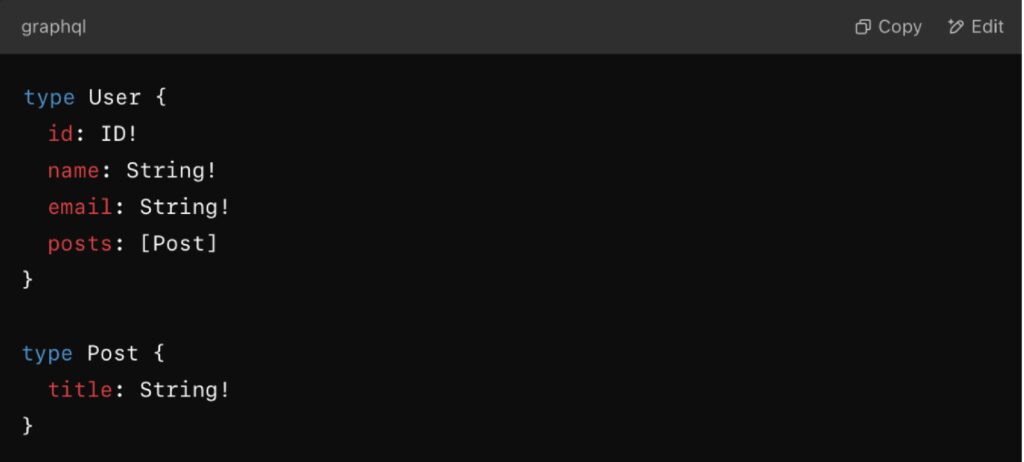
- Real-Time Subscriptions: GraphQL supports real-time updates, making it ideal for applications that require live data, like chat apps or dashboards.
REST vs. GraphQL
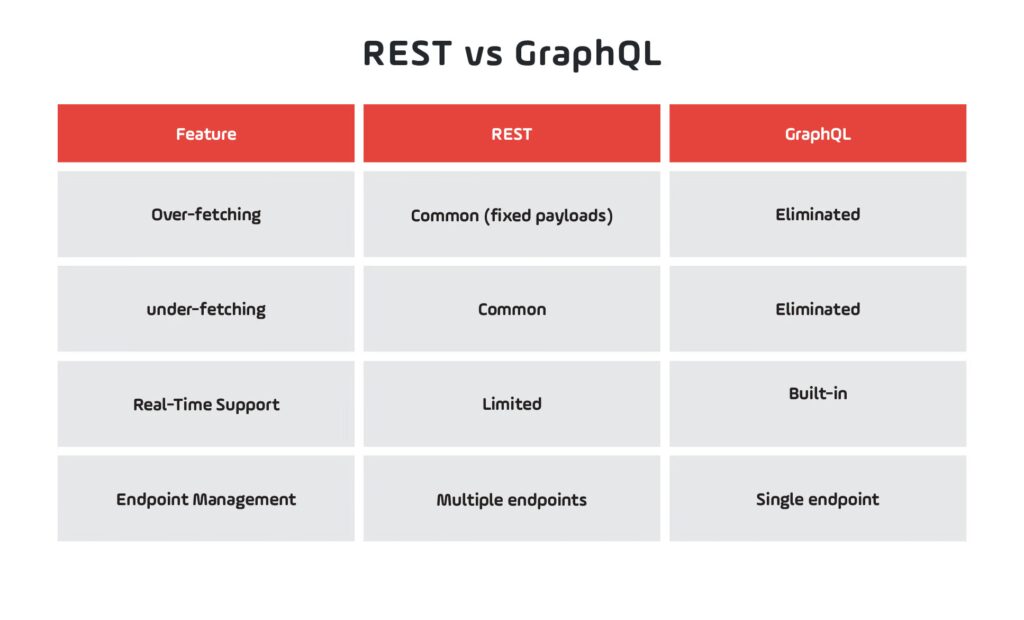
Use Cases for GraphQL
- Social Media Platforms: With nested data requirements (e.g., users, posts, comments), GraphQL reduces the number of API requests needed compared to REST.
- E-Commerce Applications: GraphQL efficiently fetches complex datasets, such as product catalogs, reviews, and user profiles, in one query.
- Real-Time Applications: GraphQL subscriptions enable live updates for features like notifications, chat, or financial dashboards.
Trend in 2025
As highlighted by Apollo GraphQL, more organizations are adopting GraphQL to optimize data fetching and improve developer experience. Its flexibility and strong community support have positioned it as a preferred alternative to REST for modern applications.
Tools and Ecosystem
- Apollo Client: A powerful client for integrating GraphQL into React and other frameworks.
- Prisma: Simplifies database access with a type-safe ORM that integrates seamlessly with GraphQL.
- GraphQL Code Generator: Automatically generates TypeScript types and hooks from your GraphQL schema.
GraphQL and Microservices
GraphQL can act as an API gateway for microservices, unifying data from multiple sources into a single queryable endpoint. This simplifies the architecture and reduces the complexity of managing multiple APIs.
Challenges and Limitations
While GraphQL is powerful, it does come with challenges:
- Complexity: Implementing a GraphQL server requires careful planning and understanding of schema design.
- Overhead: Query resolution can be slower than REST in some scenarios due to nested resolvers.
- Caching: Unlike REST, caching mechanisms like HTTP cache need custom implementation.
5. Embracing Modern JavaScript Features
Modern JavaScript (ES6 and beyond) introduces features that significantly enhance code readability, maintainability, and performance. Since ES6 was released in 2015, JavaScript has continuously evolved, offering developers powerful tools to simplify complex tasks and reduce boilerplate. In 2025, mastering these features is a must-have skill for any JavaScript developer.
Key Modern JavaScript Features
Arrow Functions
Arrow functions provide a concise syntax for defining functions and do not bind their own this context, making them particularly useful for callbacks.
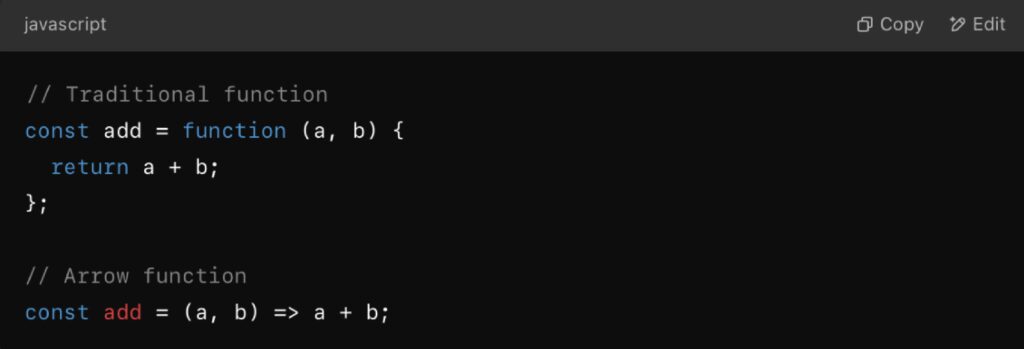
Use Case: Simplifies array methods like map, filter, and reduce.

Template Literals
Template literals allow string interpolation and multiline strings using backticks.

Use Case: Simplifies dynamic HTML generation.
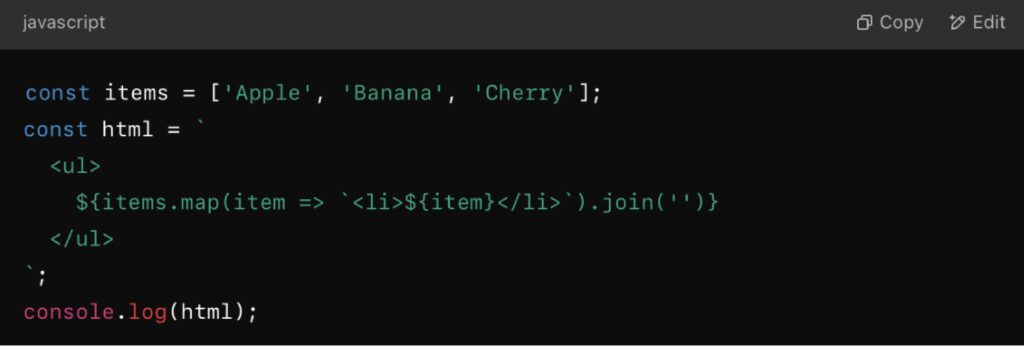
Destructuring Assignment
Extract values from arrays or objects into variables with ease.

Use Case: Simplifies state management in frameworks like React.

Optional Chaining (?.)
Safely access deeply nested properties without worrying about undefined errors.

Nullish Coalescing (??)
Provides a default value only when the left-hand operand is null or undefined.

Rest and Spread Operators
Rest collects remaining elements into an array:

Spread expands arrays or objects:

Promises and async/await
Handle asynchronous operations more effectively:

Why These Features Matter
- Improved Developer Productivity: Simplified syntax speeds up development.
- Enhanced Readability: Features like destructuring and template literals make code more concise and understandable.
- Error Reduction: Tools like optional chaining and nullish coalescing prevent common runtime errors.
Trends in 2025
Modern JavaScript features are now standard in production environments. According to the State of JavaScript 2024 survey (https://2024.stateofjs.com/en-US/features/), over 90% of developers report using ES6+ features regularly. Features like logical assignment operators (&&=, ||=) and Promise.allSettled have become essential for handling edge cases efficiently.
Tips for Mastering Modern JavaScript
- Use Online Resources:
- MDN Web Docs for detailed feature explanations.
- JavaScript.info for hands-on tutorials.
- Integrate into Real Projects:
- Use destructuring for cleaner code in state management.
- Leverage async/await for handling API requests in React or Vue applications.
- Stay Updated:
- Follow ECMAScript proposals to learn about upcoming features.
6. Advanced Asynchronous Programming
JavaScript’s asynchronous nature is one of its most powerful features, enabling developers to handle tasks like API requests, database queries, and user interactions without blocking the execution of other code. By mastering advanced asynchronous techniques, developers can build highly responsive and efficient applications.
The Basics of Asynchronous Programming
JavaScript’s event loop processes asynchronous operations through a non-blocking mechanism. Key tools include:
- Callbacks: The original method for handling asynchronous operations.

- Promises: Introduced in ES6, promises provide a cleaner way to handle async operations.

- async/await: Introduced in ES2017, async/await simplifies working with promises, making asynchronous code appear synchronous.
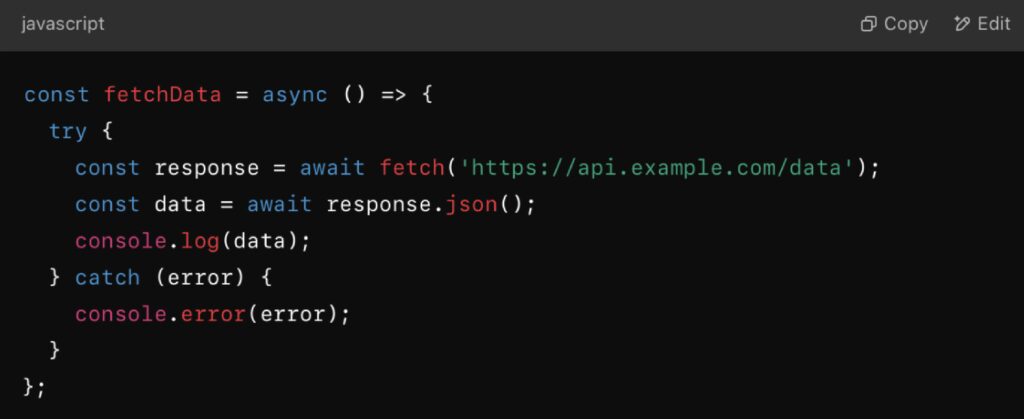
Advanced Patterns in Asynchronous Programming
- Promise.all
Executes multiple promises concurrently and resolves when all are complete. Useful for aggregating results.

- Promise.any
Resolves as soon as one promise succeeds, ignoring others.

- Promise.allSettled
Returns the result of all promises, whether fulfilled or rejected.

- Task Queues with Async Generators
Async generators handle streams of data over time.
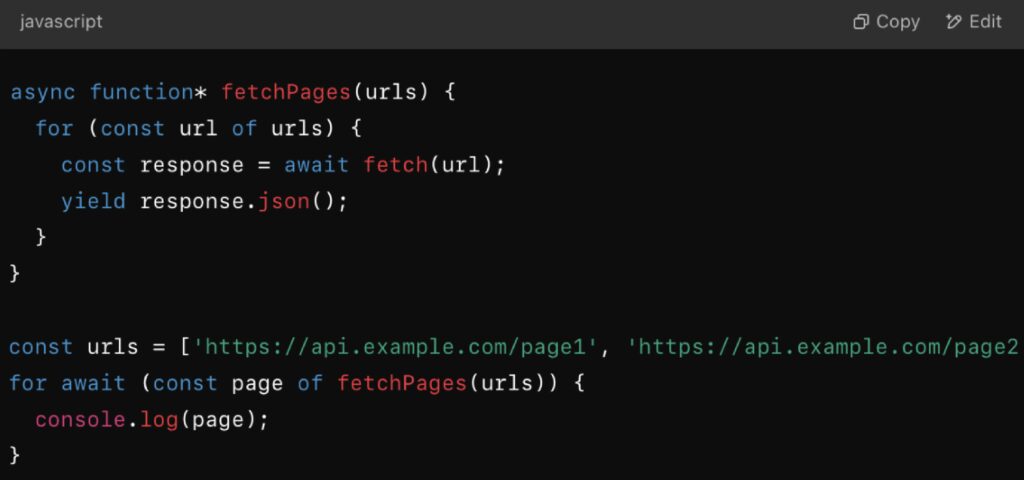
Trends in 2025
According to the State of JavaScript 2024 survey, asynchronous patterns are foundational in modern frameworks like React, Vue, and Next.js. As real-time applications grow in popularity, tools like WebSockets and Server-Sent Events (SSE) are becoming essential for handling bi-directional communication.
Real-Time Applications
Real-time data handling is a critical aspect of modern asynchronous programming. Tools like Socket.IO simplify WebSocket communication for features like:
- Chat Applications: Handling messages in real-time.
- Live Dashboards: Displaying updated statistics or analytics.
- Collaborative Tools: Supporting features like document editing.
Example: Simple WebSocket server with Node.js.

Asynchronous Programming in Frameworks
- React:
- React Suspense allows components to handle asynchronous data fetching with ease.

- Next.js:
- Server-side rendering (SSR) and static site generation (SSG) rely heavily on async/await.

- Vue:
- Vue 3’s Composition API simplifies managing async operations in components.
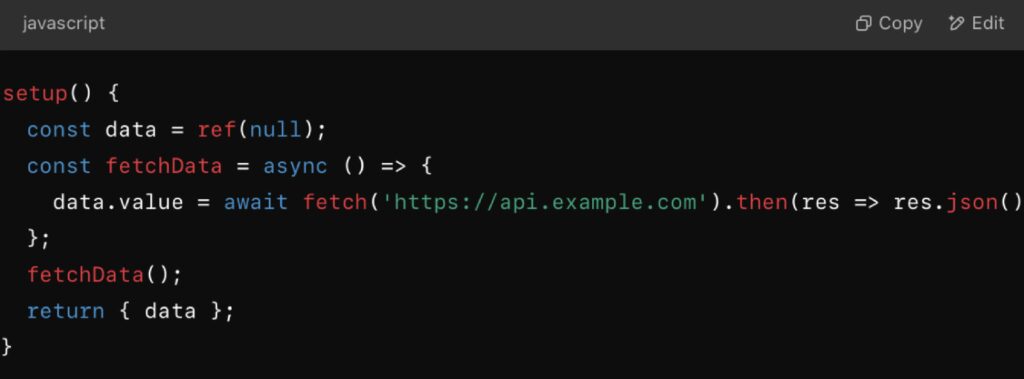
Pro Tip
Use libraries like Axios to simplify error handling and request cancellation for better control over asynchronous operations.
7. TypeScript Integration
TypeScript has become a cornerstone of modern JavaScript development. By adding static typing and advanced tooling support, TypeScript empowers developers to write safer, more scalable, and maintainable code. With its rising adoption in large-scale applications, TypeScript is now an essential skill for developers in 2025.
What is TypeScript?
TypeScript is a superset of JavaScript that adds static typing, allowing developers to define the types of variables, functions, and objects. This reduces runtime errors and improves the developer experience through better tooling, such as IntelliSense and type-checking.
Core Features of TypeScript
- Static Typing
TypeScript enforces type definitions, ensuring errors are caught during development rather than runtime.

- Interfaces and Type Aliases
Interfaces allow you to define the structure of objects.
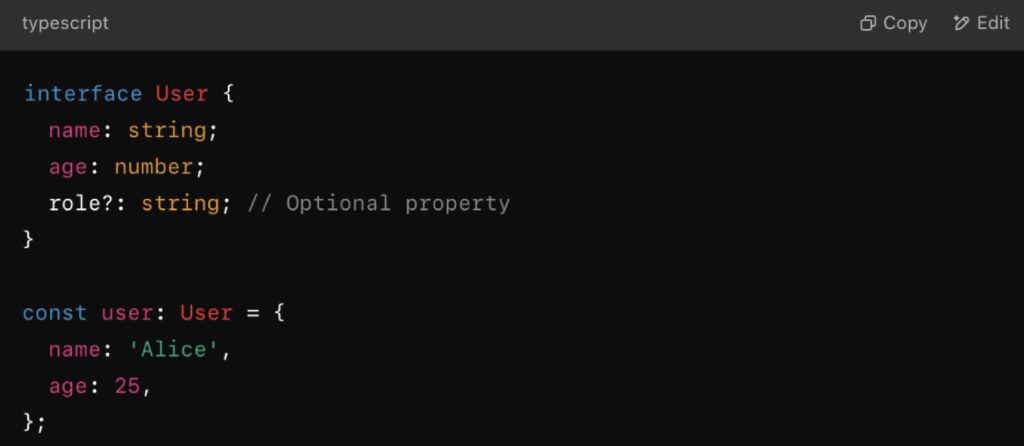
- Enums
Enumerations provide a way to define named constants.
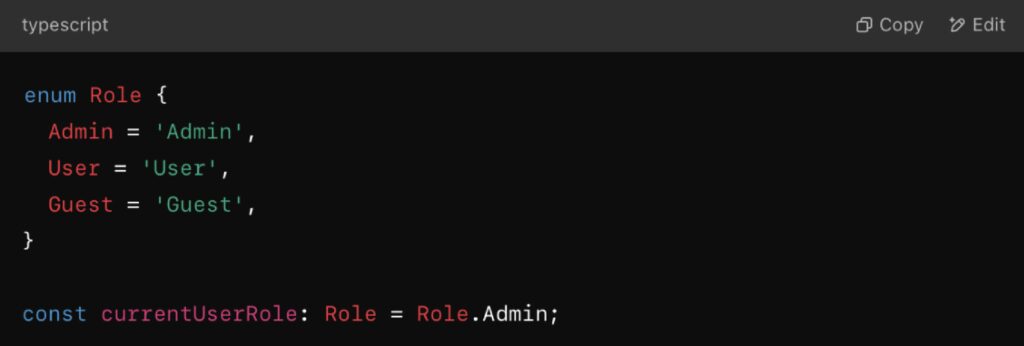
- Generics
Generics allow you to create reusable components with type safety.

- Type Inference
TypeScript can infer types automatically, reducing the need for explicit annotations.

Benefits of TypeScript
- Error Prevention: TypeScript identifies errors during development, preventing runtime issues.
- Improved Tooling: IDEs like VS Code provide better autocompletion and refactoring capabilities.
- Scalability: Static typing ensures maintainability in large projects with multiple developers.
- Interoperability: TypeScript compiles to plain JavaScript, making it compatible with any JavaScript environment.
TypeScript with Popular Frameworks
- React
TypeScript pairs seamlessly with React, providing type safety for props and state.
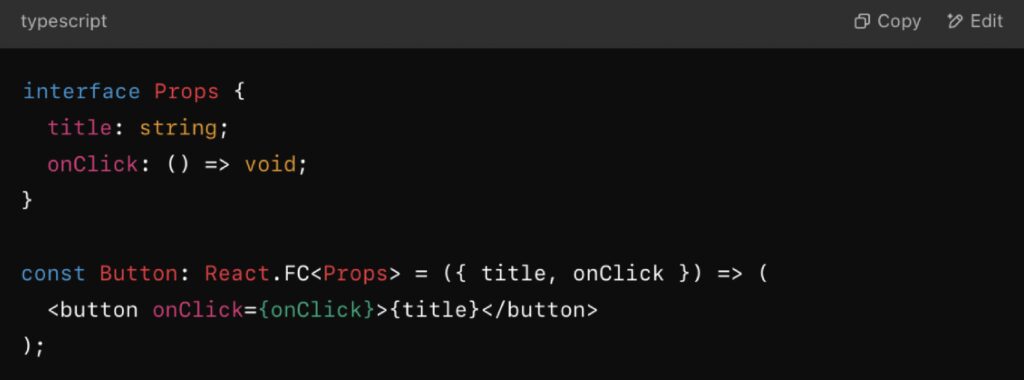
- Node.js
TypeScript enhances server-side development with Node.js by ensuring the correctness of APIs and middleware.
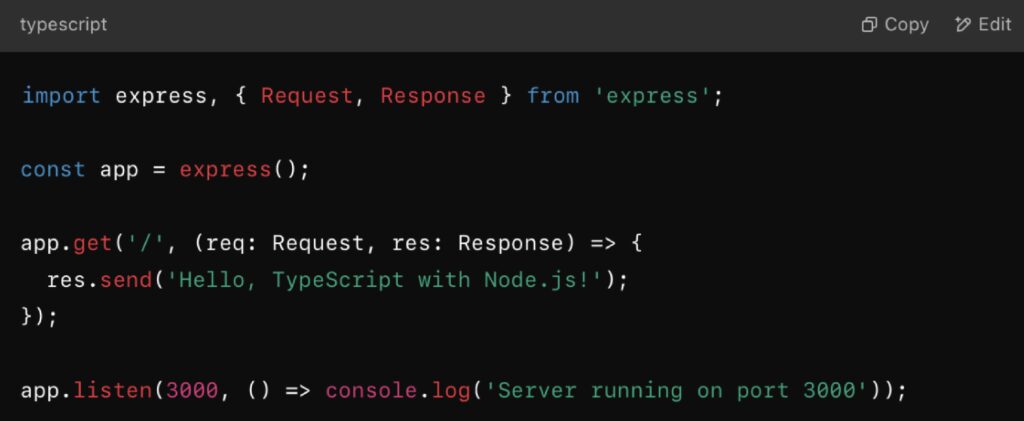
- Vue
Vue 3’s Composition API was designed with TypeScript in mind.
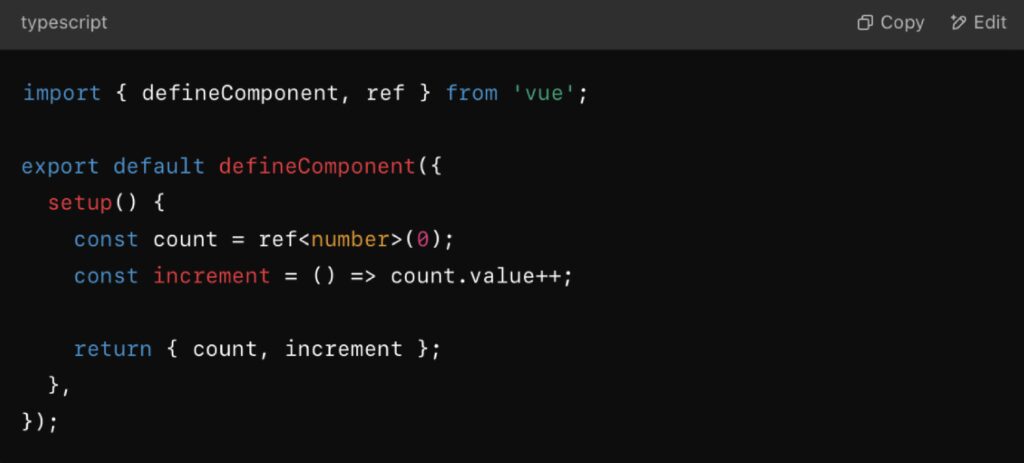
Trend in 2025
According to JetBrains’ Developer Ecosystem report, over 75% of large-scale applications use TypeScript for its static typing and tooling benefits. Frameworks like Angular and Deno have built-in TypeScript support, making it a default choice for new projects. Additionally, libraries like NestJS are further driving TypeScript’s adoption in backend development.
Pro Tips for Mastering TypeScript
- Start Small: Gradually introduce TypeScript into existing JavaScript projects by converting one file at a time.
- Use Linting Tools: Pair TypeScript with ESLint for consistent code quality.
- Explore Libraries:
TypeScript has evolved from an optional tool to an industry standard for building scalable and maintainable JavaScript applications. By integrating TypeScript into front-end frameworks like React and back-end tools like NestJS, developers can write robust and error-free code. In 2025, mastering TypeScript is critical for staying competitive in the modern development landscape.
8. WebAssembly Interoperability
WebAssembly (WASM) has transformed web development by enabling high-performance code execution in the browser. Originally designed to complement JavaScript, WebAssembly now supports a wide range of languages, including Rust, C++, and Go. It’s particularly well-suited for computationally intensive applications like gaming, video editing, and data visualization.
What is WebAssembly?
WebAssembly is a binary instruction format designed for safe, fast, and portable code execution. It is supported by all major browsers and can run alongside JavaScript, allowing developers to write performance-critical parts of their applications in languages other than JavaScript.
Core Features of WebAssembly
- Near-Native Performance
WASM executes code at speeds close to native applications, thanks to its low-level, binary format and efficient memory management. - Language Interoperability
WebAssembly modules can be compiled from various languages, making it possible to leverage existing codebases written in Rust, C, or Go. - Sandboxed Execution
WASM modules run in a secure environment, isolating them from the host system and preventing malicious actions. - Portability
WASM modules are platform-agnostic, ensuring they can run on any device with a modern browser.
How WebAssembly Works with JavaScript
WebAssembly does not replace JavaScript; instead, it complements it. JavaScript acts as the glue code to load, configure, and interact with WebAssembly modules.
Example: Simple WebAssembly Integration
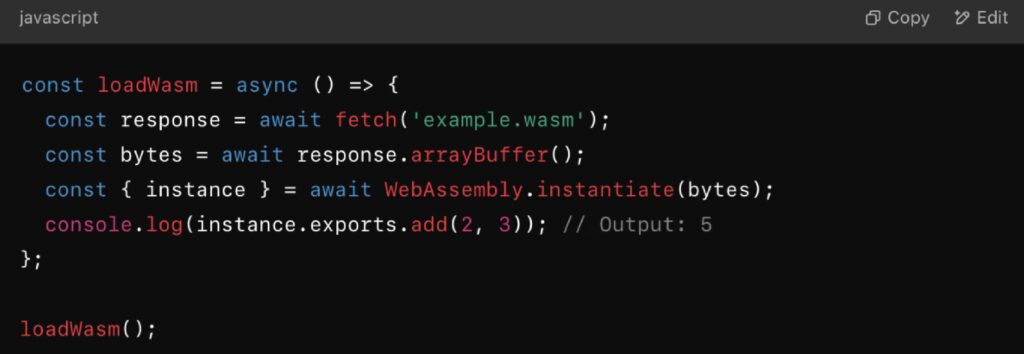
Use Cases for WebAssembly
- Gaming: WASM is ideal for browser-based 3D games, providing the performance required for rendering complex scenes in real-time.
- Video Processing: Tools like FFmpeg compiled to WebAssembly allow developers to process video files directly in the browser without additional plugins.
- Machine Learning: Frameworks like TensorFlow.js leverage WASM for faster in-browser model inference.
- Data Visualization: High-performance charting and simulation tools can use WebAssembly to handle large datasets efficiently.
Trends in 2025
According to WebAssembly.org, WASM’s adoption is accelerating, with an increasing number of applications using it for performance-critical tasks. Recent developments include:
- WASI (WebAssembly System Interface): Expands WASM beyond browsers, enabling server-side and command-line use cases.
- Framework Support: Frameworks like Blazor use WebAssembly to run .NET code in the browser.
- Cloud Computing: WebAssembly is becoming popular in serverless and edge computing environments for its lightweight and portable nature.
WebAssembly Frameworks and Tools
- AssemblyScript: A TypeScript-like language that compiles to WebAssembly, making it easy for JavaScript developers to adopt.
- Emscripten: A toolchain for compiling C and C++ code to WebAssembly.
- TensorFlow.js WASM Backend: Enhances TensorFlow.js performance by running operations on WebAssembly.
Challenges of WebAssembly
- Debugging: Debugging WebAssembly code can be challenging due to its low-level nature.
- File Size: WebAssembly modules can be larger than JavaScript files, increasing initial load times.
- Learning Curve: Developers may need to learn new languages like Rust or adapt existing codebases for WebAssembly.
Pro Tip:
Use tools like wasm-opt (https://github.com/WebAssembly/binaryen) to optimize WebAssembly modules for smaller file sizes and faster performance.
WebAssembly is reshaping the way developers think about performance-critical applications in the browser and beyond. By combining WebAssembly with JavaScript, developers can achieve near-native speeds while maintaining the flexibility of the web platform. As WebAssembly adoption grows, mastering its tools and techniques will be key to building the next generation of high-performance applications.
9. ECMAScript 2024 Features
JavaScript evolves annually through ECMAScript updates, which introduce new language features aimed at improving performance, simplifying code, and enhancing developer productivity. In 2024, the ECMAScript standard delivered several exciting features that have already started reshaping how developers approach problem-solving.
Highlighted Features of ECMAScript 2024
- Object.groupBy and Object.partition
These methods simplify the process of grouping and partitioning arrays based on criteria, reducing boilerplate code.
- Object.groupBy:

- Object.partition:

Use Case: Data categorization, such as grouping students by grades or splitting datasets based on thresholds.
- Promise.withResolvers
- A new utility that simplifies the creation and management of promises by returning the promise along with its resolve and reject functions.

Use Case: Improves readability when creating custom asynchronous workflows, such as managing timers or external events.
- Hashbang (#!) Support in Scripts
The addition of hashbang support enables JavaScript files to be executed directly in environments like Node.js without the need for additional shell commands.

Use Case: Writing CLI tools and scripts with JavaScript for environments that support direct execution.
- Symbol-Based Features for Enhancements
Symbols gained new methods in 2024, allowing developers to better manage metadata and custom object behavior.
Why These Features Matter
- Simplified Code: Features like Object.groupBy and Promise.withResolvers reduce the amount of boilerplate code needed for common tasks.
- Improved Productivity: Hashbang support and built-in utilities streamline workflows for developers working on CLI tools and server-side applications.
- Enhanced Readability: New methods promote clearer, more declarative code.
Trends in 2025
Developers are adopting ECMAScript features faster than ever, driven by frameworks and tooling that integrate new standards almost immediately. According to the State of JavaScript 2024 survey (https://2024.stateofjs.com/en-US/features/), developers rank modern ECMAScript updates as critical for keeping JavaScript competitive against languages like TypeScript and Python.
Pro Tips for Leveraging ECMAScript 2024
- Stay Updated: Regularly check the TC39 proposal tracker (https://tc39.es/proposals/) to learn about upcoming features.
- Use Polyfills: For older browsers, use polyfills like core-js to ensure compatibility with modern features.
- Integrate into Projects: Start incorporating new features like Object.groupBy into real-world applications to simplify data manipulation tasks.
ECMAScript 2024 continues JavaScript’s tradition of delivering powerful features that simplify coding and enhance developer productivity. By leveraging tools like Object.groupBy, Promise.withResolvers, and hashbang support, developers can write cleaner, more efficient code. Staying ahead of these updates ensures you’re equipped to tackle modern challenges with the latest and greatest that JavaScript has to offer.
10. Security Best Practices
As JavaScript remains one of the most widely used programming languages for web and server-side development, its applications are a prime target for security vulnerabilities. Implementing robust security practices is critical to protect applications and their users from common threats like cross-site scripting (XSS), SQL injection, and data breaches.
Common JavaScript Security Vulnerabilities
Cross-Site Scripting (XSS)
XSS occurs when attackers inject malicious scripts into web pages viewed by users. It often happens when user input is rendered directly in the DOM without proper sanitization.
IMAGEM
Prevention:
- Use libraries like DOMPurify to sanitize user inputs.

Cross-Site Request Forgery (CSRF)
CSRF attacks trick authenticated users into performing unintended actions, such as transferring funds or changing account details.
Prevention:
- Use CSRF tokens to validate requests.
- Implement the SameSite attribute on cookies.
SQL Injection
Attackers can inject malicious SQL queries into an application’s database through improperly sanitized input fields.
Prevention:
- Use parameterized queries or ORM libraries like Sequelize to prevent SQL injection.
Insecure Dependencies
Many JavaScript projects rely on third-party packages. If these packages are outdated or compromised, they can introduce vulnerabilities.
Prevention:
- Regularly audit dependencies with tools like npm audit or Snyk.

Key Security Best Practices
Sanitize and Validate User Input
Always sanitize input to prevent malicious code execution.

Implement Content Security Policy (CSP)
A CSP helps prevent XSS attacks by restricting the sources from which scripts, styles, and other resources can be loaded.

- Use HTTPS
HTTPS encrypts data in transit, preventing attackers from intercepting sensitive information.- Obtain SSL/TLS certificates from trusted authorities like Let’s Encrypt (https://letsencrypt.org/).
- Redirect all HTTP traffic to HTTPS.
- Secure Authentication and Authorization
- Use strong password policies and implement Multi-Factor Authentication (MFA).
- Use libraries like Passport.js for secure authentication in Node.js applications.
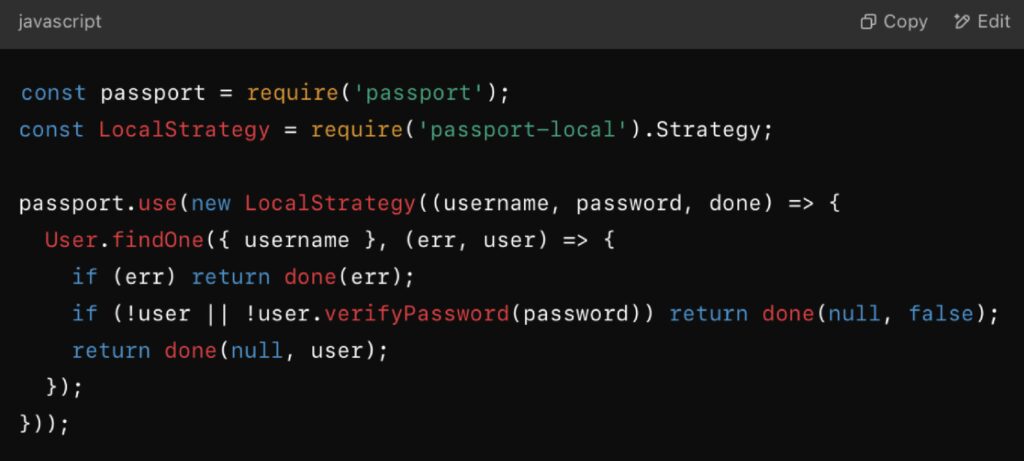
- Avoid Exposing Sensitive Data
- Never store passwords in plain text; always hash them using libraries like bcrypt.

- Use environment variables to store API keys and secrets securely (e.g., with dotenv).
- Secure Dependencies
Keep dependencies up to date and minimize the use of unnecessary libraries.

Trends in 2025
- Automated Security Testing
Tools like OWASP ZAP and Burp Suite are increasingly used to automate vulnerability scanning during the development lifecycle. - Zero Trust Architecture
Adopting a Zero Trust model, which assumes all requests are untrusted until verified, is becoming the norm in web application security. - Runtime Protection
Modern runtime protection tools, such as Sqreen and Runtime Application Self-Protection (RASP), provide real-time monitoring and threat mitigation. - Serverless Security
With the rise of serverless platforms like AWS Lambda and Azure Functions, developers are focusing on securing the function’s execution environment, configurations, and access policies.
Advanced Use Cases
- Protect APIs with Rate Limiting
Prevent abuse by limiting the number of requests a client can make in a given period.
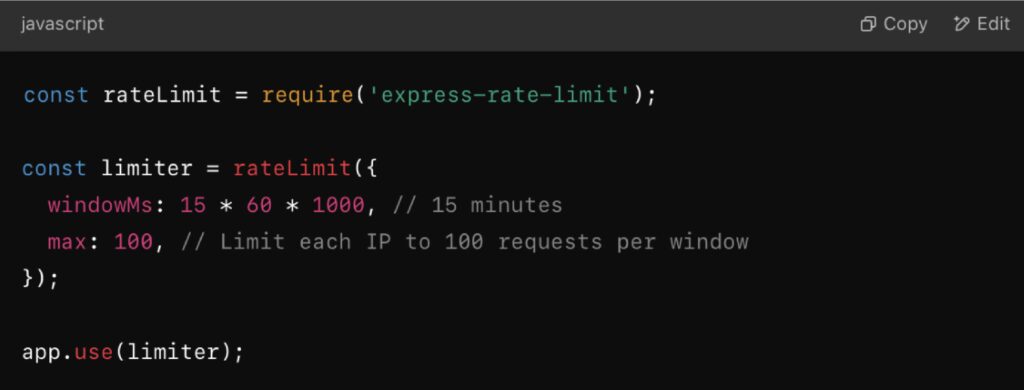
- JWT-Based Authentication
JSON Web Tokens (JWT) securely transmit information between parties.

- Implementing CSP in React
Define CSP headers for React applications to limit script and resource origins.

Pro Tips for Securing JavaScript Applications
- Perform Regular Audits: Use tools like Dependabot to detect vulnerabilities in your dependencies.
- Adopt Secure Coding Practices: Follow guidelines from the OWASP Secure Coding Practices Checklist.
- Educate Your Team: Regularly train developers on common security risks, such as those listed in the OWASP Top 10.
Staying Ahead: Mastering JavaScript’s Ever-Evolving Landscape
JavaScript continues to be the driving force behind web development, offering unparalleled flexibility and innovation. In 2025, its reach has expanded far beyond traditional browser-based applications, powering everything from high-performance server-side solutions with Node.js to cutting-edge client-side frameworks like React and Vue. The language’s ecosystem is a testament to its evolution, with modern tools and features like Vite, GraphQL, TypeScript, and WebAssembly pushing boundaries in performance, scalability, and developer experience.
However, thriving in the world of JavaScript requires more than just keeping up with its syntax—it demands an active effort to adopt emerging technologies, understand the latest features, and refine best practices. Whether it’s mastering advanced asynchronous patterns, optimizing APIs with GraphQL, or ensuring security through robust CSP implementations, developers need to stay informed and adaptable.
Looking ahead, trends like serverless architectures, edge computing, and performance-focused advancements (e.g., WebAssembly) hint at the continued innovation in the JavaScript ecosystem. By embracing these trends and leveraging modern tools, developers can ensure they remain at the forefront of web development, building secure, performant, and user-friendly applications.
For more insights into JavaScript trends, career advice, and tutorials, explore the resources on Growin’s blog. Whether you’re a seasoned developer or just starting out, there’s always something new to learn in the ever-evolving world of JavaScript.Image Suggestion: A roadmap illustration showing JavaScript’s evolution, from ES6 to 2025, highlighting major tools and trends.


